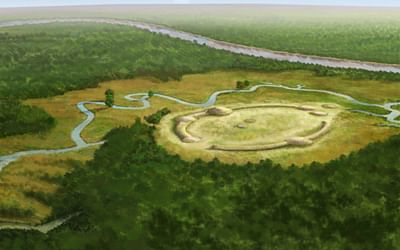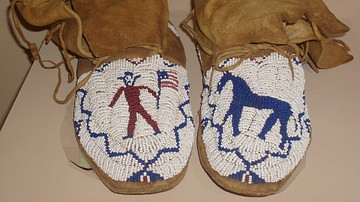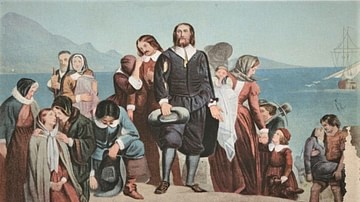The history and culture of the Native Peoples of North America are often overlooked as they have been largely eclipsed by the history of the European settlers who colonized the region beginning in the 17th century. The original inhabitants of the land have a long past, however, which deserves wider recognition and respect.
According to modern-day non-Native scholars, those now known as Indigenous Americans migrated into North America between 40,000-14,000 years ago, but in the belief systems of the people themselves, they came from the land – known to many Native nations as Turtle Island – and have always been a part of it. Native American nations developed highly sophisticated and diverse cultures, which were maintained for thousands of years prior to the European colonization of the Americas, which significantly decreased the indigenous population through diseases and warfare and deprived survivors of their ancestral lands through legislation, forced relocation, and treaties which were then not honored by the United States government.
The Doctrine of Discovery held that any lands not claimed by a Christian sovereign were free for the taking by any other without regard for those who were already living in those regions. From the foundation of the Jamestown Colony of Virginia in 1607 onwards, the spirit of this doctrine dictated how the colonizers would treat the indigenous peoples of North America, including the attempts at erasing their history, culture, and language since they were regarded as 'uncivilized savages.' Actually, Native American culture was as highly developed and far more inclusive than that of the European colonizers.
Native American Nations prior to colonization waged war, conquered lands, held slaves, depleted natural resources, and were no more the 'noble savage' of 18th- and 19th-century American literature than their characterization as the 'savage brute'. As Euro-Americans came to dominate North America, the settlers tended to demonize or idealize the indigenous people, but they were just people – with the same basic desires all people have – only expressing them differently than what was acceptable to the Europeans and later Euro-Americans, who quietly, and often not so quietly, tried to erase the indigenous cultures and the people themselves.
The Native Peoples of North America survived, however, and still form vital communities observing traditional rites, telling ancient stories, and teaching their language and customs to their youth. The following ten facts are only a small sampling of their vast culture, history, and contributions, but the books listed in the bibliography following the article will provide readers with many others.
Watson Brake Pre-Dates the Great Pyramid of Giza
The Great Pyramid of Giza is dated to 2589-2566 BCE, the reign of the king Khufu (Cheops) of 4th Dynasty Egypt, but the site now known as Watson Brake in modern-day Louisiana dates to c. 3500 BCE. Consisting of eleven mounds, the original purpose of the site continues to challenge archaeologists and historians as it does not seem to have been constructed as a residential, commercial, or religious center. Ceramics and tools found at Watson Brake attest to human activity dating to at least c. 3500 BCE, but it is unclear what the people were doing there. The site was discovered only as recently as the 1980s, however, and so archaeologists seem confident that further excavations will bring the purpose of the place into clearer focus. Watson Brake is only one of many ancient Native American sites throughout the USA – including Cactus Hill, Poverty Point, Serpent Mound, Etowah Mounds, Moundville, and Cahokia, among others – but, so far, it is the oldest mound complex discovered to date.

Cahokia Was the Largest City in North America
Cahokia, in modern-day Illinois, dates to c. 600 to c. 1350 CE and was once the largest urban center in North America. The city was a major religious site and trade hub, flourishing through routes running in every direction. The site covers 2,200 acres (890 ha) and once included residences, a large commercial district, ball courts and playing fields – the popular Native American game of Chunkey (Tchung-kee) is thought to have originated here c. 600 CE – agricultural areas, and ceremonial-religious spaces. The original name for the city is unknown, and the modern designation comes from the Cahokia tribe who lived nearby in the 19th century. The original occupants of the city were initially thought to have mysteriously vanished (and some articles and videos still advance this claim), but archaeologists now believe the site was abandoned at some point c. 1350 CE due to natural disasters (notably earthquakes and floods) and overpopulation. The site was repopulated by the 1500s by the people of the Illinois Confederacy, who were still there in the 1800s but had no knowledge of who had built the city that is a UNESCO World Heritage Site today.
Pre-Colonial North Americans Spoke Over 300 Languages
Prior to European colonization, there were over 300 languages spoken by the North American Natives, and according to some estimates, possibly as many as 500. Each nation spoke its own language and communicated with others either through interpreters or sign language. As part of the US government's policy of assimilation, Native American languages were discouraged, and beginning in the early 19th century, children were taken from their parents and moved to boarding schools where they learned English and were taught to embrace European culture, religion, and values. Native Americans were not allowed to speak or teach their own languages until the 1970s, and by that time, many had been lost. Today, there are only approximately 170 Native American languages spoken in the USA. Native American initiatives to revive their ancestral languages are ongoing, however, encouraging a reconnection with the traditions of the past.
Native Americans First Cultivated Important Crops
Some of the most important crops worldwide today were first cultivated by the North American Natives. Corn was introduced from South and Central America at some point during the Archaic Period (c. 2100 BCE) and came to be a staple crop across North America along with beans and squash. All three were grown together through the practice known as the 'three sisters' of agriculture, still practiced today. In 'three sisters companion planting', the corn is planted first, the beans second (which wrap around the corn stalk), and then the squash whose leaves shade the roots of the beans and corn. Along with these, Native Americans also grew, and continue to cultivate, gourds, potatoes, sunflowers, tobacco, tomatoes, plums, and many other crops.
Seven Generations Principle
The Seventh Generation Principle (also known as Seven Generation Sustainability and Seven Generations Planning) is believed to have originated with the Iroquois nation and maintains that every decision made by a people should consider the effects it will have on their descendants seven generations into the future. This policy is in keeping with the cultural value of Native American nations generally that the good of the community as a whole is more important than the needs of the individual or the minority and that people are stewards, rather than owners, of the land and so the needs of the earth should always be considered. As the earth is understood as a living being, it is regarded as a member of the community, and by extension, so are all the animals and the plant life the earth supports. By considering the effects of their actions on the seventh generation, the people are not only thinking of their descendants but of the continued well-being and sustainability of the entire community.
USA Constitution Modeled on Haudenosaunee Confederacy
The Seven Generations Principle is said to have guided the decisions made by the Haudenosaunee Confederacy of the Five Nations of the Iroquois – Cayuga, Mohawk, Oneida, Onondaga, and Seneca – later known as the Six Nations after the inclusion of the Tuscarora. The Grand Council of the Six Nations was a democracy in which women had an equal voice and the Great Law of Peace was understood to include everyone. The structure of the government of the Haudenosaunee Confederacy was set down in a constitution that mandated the separation of powers into different branches and responsibilities and declared the authority of the government came from the governed. The Founding Fathers of the United States drew on this model to create their own form of government.
Women as Equals
The concept of the good of the community prevailing over that of the individual or minority extended to women, not only among the Iroquois but also throughout North American nations generally. Women were responsible for trade, construction and maintenance of the home, could divorce their husbands and retain the home and possessions, and had an equal voice in government. The Iroquois, however, directly influenced the women's suffrage movement of the 19th century in the USA as early activists including Lucretia Mott, Elizabeth Cady Stanton, and Matilda Joslyn Gage cited the Iroquois women as enjoying greater liberties than white women. Still, once women were given the right to vote through the 19th Amendment in 1920, many spoke out against that same right being extended to Native Americans, who were prohibited from voting until 1924 with the passage of the Indian Citizenship Act, and even then, some states continued to disenfranchise Native Americans until the 1950s.
Vast Body of Literature
North American nations produced a significant body of literature, initially passed down orally generation to generation, before stories, poems, songs, and longer works comparable to the novel were committed to writing. Every nation had its own stories which kept the past alive while also transmitting important cultural values. Works were eventually written down by white settlers interested in Native culture, such as anthropologist George Bird Grinnell, and by Native American authors themselves including Charles Eastman, John Rollin Ridge, Lynn Riggs, Zitkala-Sa, N. Scott Momaday, Louise Erdrich, and Sherman Alexie, among many others. Storytelling has always been, and continues to be, a vital aspect of Native American culture and their literature includes epic adventures, ghost stories, love stories, origin myths, and many other genres.
Turtle Island
Many Native American origin myths relate how the world (or North America) was formed on the back of a turtle, and so some nations, including the Iroquois, refer to the continent as Turtle Island – a term also used for the Earth as a whole by other nations. In the Iroquois creation myth, there was an Upper and Lower world and the lower was entirely water. The daughter of the Great Ruler of the Upper World, close to delivering her child, lay down on a cloud which began to sink toward the Lower World. The creatures of the Lower World scrambled to find something she could safely land upon, and the turtle agreed to have mud from the bottom of the endless sea heaped upon his back. As the muskrat dove deep and brought up earth to smooth across the turtle's shell, the birds guided the cloud and sleeping goddess toward it. The turtle then became known as Earth Bearer and the land as Turtle Island.
Indian Removal Act of 1830
North American Natives began losing their land on Turtle Island when Europeans arrived in the late 16th and early 17th centuries, claiming territory as their own according to their understanding of the Doctrine of Discovery. In the region now known as New England, Native Americans were steadily deprived of their ancestral lands beginning in 1620 and, as more Europeans arrived, more land was lost. The Indian Removal Act of 1830 authorized agents of the US government to remove Native Americans from their homelands east of the Mississippi to regions out west designated as 'Indian Territory', primarily the modern state of Oklahoma. This policy resulted in the deaths of many Native Americans, especially in 1838-1839 among the Cherokee Nation who referred to their relocation as the Trail of Tears. The Indian Removal Act, under President Andrew Jackson, has since been condemned, and the 2007 Declaration on the Rights of Indigenous Peoples recognized that Native Americans are entitled to their land, but so far, few efforts have succeeded in returning very much of it. The Land Back Movement presently works toward this goal.
Conclusion
The Land Back Movement is not seeking to deprive modern-day Americans of their lands and homes but only the return of ancestral lands and recognition of Native American legal rights to those lands. In this same way, Native American organizations such as Native Hope and First Nations Development Institute, as well as tribal societies and associations, seek to elevate awareness of Native American culture, history, and traditions.
There are many fascinating aspects of Native American culture and the various nations differed significantly in many respects. The story of the origin of the world, for example, is quite different among the people of the Plains Indians Culture, such as the Sioux and Pawnee, than the Iroquois version given above, and among the Iroquois, as with other nations, there are many different versions of the same story. Native American Heritage Month, observed in the USA every year in November, celebrates this diversity and the heritage of the over 575 Native nations currently in the USA, encouraging Natives and non-Natives to engage with and appreciate the culture of the people who first built their homes and raised the cities across Turtle Island.









